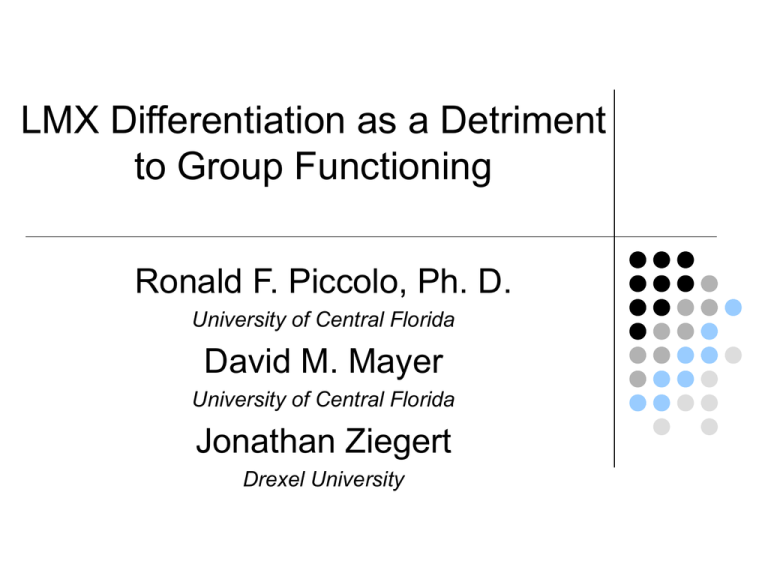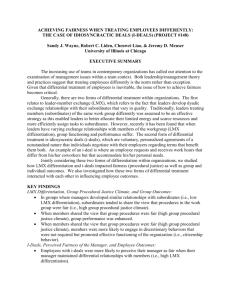LMX Differentiation
advertisement

LMX Differentiation as a Detriment to Group Functioning Ronald F. Piccolo, Ph. D. University of Central Florida David M. Mayer University of Central Florida Jonathan Ziegert Drexel University The Current Study The purpose of this study is to examine the effects of leader-member exchange (LMX) differentiation on group functioning and performance among high technology manufacturing groups. LMX differentiation indicates the extent to which the leader of a work group develops strong and resourceful relationships with some employees but not others, thus differentiating among members of the same work group. LMX Differentiation Original theorizing on LMX… This idea has gotten support in the literature (e.g., Liden, Sparrowe & Wayne, 1997; Sparrowe & Liden, 1997) – primary arguments that differentiation is beneficial to productivity Emphasized the value of differentiated relationships among supervisor and his or her employees (Dansereau et al., 1975), promoting the development of in-groups and out-groups of employees as a means to increase work-group productivity. Differentiation reflects a leader’s strategic decision to invest time and energy in fostering relationships with high value, highly productive employees, while limiting investment in employees who are either unwilling or unable to achieve above average work results Naidoo et al. (SIOP, 2009). A Longitudinal Examination of LMX, Differentiation, and Team Performance In 3 studies, LMX differentiation positively affects team performance at certain time periods However… Several recent studies (Graen & Uhl-Bien, 1995; Maslyn & UhlBien, 2005; Scandura, 1999; Schyns, 2006): Regard differentiation as a violation of fairness and justice principles Recognize the potential problems of low quality LMX relationships Suggest that differentiation will have an unfavorable influence on group performance. LMX differentiation is likely to result in a host of negative outcomes, including conflict among members and an unwillingness by less favored group members to cooperate with their more favored counterparts. The Current Study We examine the impact of LMX differentiation on group functioning, as measured by the quality of motivational, affective, and conflict management processes in groups (e.g., Marks et al., 2001). We examine the extent to which interpersonal justice perceptions shape the manner in which differentiation affects group functioning and performance. Perhaps, the negative effects of LMX differentiation are offset by perceptions of fair interpersonal treatment by a supervisor. We seek to extend LMX research beyond its traditional, individual-level-of-analysis design, which often fails to recognize the fact that supervisor-subordinate relationships do not exist in a vacuum, but are embedded in a rich social and professional context. Examining LMX relationships in isolation, without consideration of the social context in which these relationships exist, is insufficient to explain leadership effectiveness and group-level phenomenon (House et al., 1995). Proposed Model Interpersonal Justice LeaderMember Relations LMX Differentiation Nature and Quality of Team Interaction Team Process Group Performance Objective Performance Team Process Marks, M. A., Mathieu, J. E., & Zaccaro, S. J. (2001). A temporally based framework and taxonomy of team processes. Academy of Management Review, 26, 356-376. Marks, M. A., Mathieu, J. E., & Zaccaro, S. J. (2001). A temporally based framework and taxonomy of team processes. Academy of Management Review, 26, 356-376. Marks, M. A., Mathieu, J. E., & Zaccaro, S. J. (2001). A temporally based framework and taxonomy of team processes. Academy of Management Review, 26, 356-376. Mission Analysis Strategy Formulation Transition Processes Goal Specification Monitoring Progress Systems Monitoring Action Processes Team Monitoring Group Performance Coordination Conflict Management Motivation Building Interpersonal Processes Affect Management Hypothesis: The nature and quality of team interaction has a positive impact on group performance (i.e., high quality interaction → high performance) Team Leader-Member Relations LMX Differentiation How strongly do you agree with each of the following statements? The team leader has an effective working relationship with some employees, but ineffective working relationships with other employees. The team leader lets some employees get more breaks than others. The team leader prefers some employees more than others. The team leader is more likely to point out mistakes of certain employees but not those of others. The team leader is more likely to express appreciation to some employees but not others. Why differentiation? 1) Time Constraints; 2) Multiple Jobs; 3) Personal Factors Transition Processes Differentiated Relationships between Team Leader and Team Members Action Processes Group Performance Interpersonal Processes Hypothesis: Differentiated relationships between team leader and team members has a negative effect on the quality of team interaction (i.e., high differentiation → low quality team interaction) Method Data Collected at All Employee Annual Meeting at Large Defense Contractor (High Tech Manufacturing) Individual Responses = 223 Groups (Teams) = 19 Team Size ranged from 6 to 18 Measures assessed in Survey: Team Processes Team Leader Relations Interpersonal Justice Objective Performance Ratings collected in six consecutive months Multidimensional Team Process Correlations with Objective Performance r Transition .38 Action .44 Interpersonal .42 LMX Differentiation Trans Action Inter -.47 -.50 -.71 Subjective Objective -.39 -.40 Note. Average Intercorrelation among team process dimensions = .93 When team members perceived high levels of differentiation by the team leader, those perceptions were revealed in lower quality interactions among team members – and lower scores on two indications of team performance (Subjective & Objective). Correlations m SD 1 2 3 1. LMX Differentiation 2.62 .60 (.94) 2. Team Process 3.24 .44 -.58* (.90) 3. Interpersonal Justice 3.69 .42 -.76* .79* (.97) 4. Objective Performance 93.91 6.26 -.40† .42* .23* Note. n=20. *p<.05. † p<.10. Main effect of Differentiation on Objective Performance (p<.10) is mediated by Team Process. Interpersonal Justice To what extent has your leader… Treated employees in a polite manner? Treated employees with dignity? Treated employees with respect? Refrained from improper remarks or comments? LMX Differentiation x IJ Differentiation affects quality of team interaction, but negative effects could be offset when leaders treat all team members fairly (with dignity) – even though relationship quality varies LMX x IJ → Team Process LMX Differentiation x IJ: b = -1.45† Differentiation & Variability We had objective performance for six consecutive months Reliability, Consistency, and Efficiency are particularly important metrics for these manufacturing groups How does differentiation impact performance variability? r LMX Diff – STDEV = .50* Summary We examine LMX differentiation at the team level LMX Differentiation has negative effect on team process and performance Is differentiation positive or negative in group context? Perceived differentiation on the part of the leader may reveal itself in low quality interaction and group performance Differentiation might be detrimental in group context Main effect is explained by the nature and quality of interaction among team members Multiple leader behavior might interact in shaping the manner in which team members interact with one another and ultimately perform Limitations & Future Research Group-level Sample Size = 20 Significance of conclusions is limited High correlations between LMX Differentiation, Interpersonal Justice, & Interpersonal Facilitation High correlations among Team Process subdimensions Future Research Theoretical Platform for examination of performance variability Alternative Leader or Team-oriented characteristics that minimize the impact of LMX Differentiation (e.g., cohesion, potency) Alternative measure of Differentiation Integrate individual-level outcomes (e.g., OCB, withdrawal, effort) Thank You!









